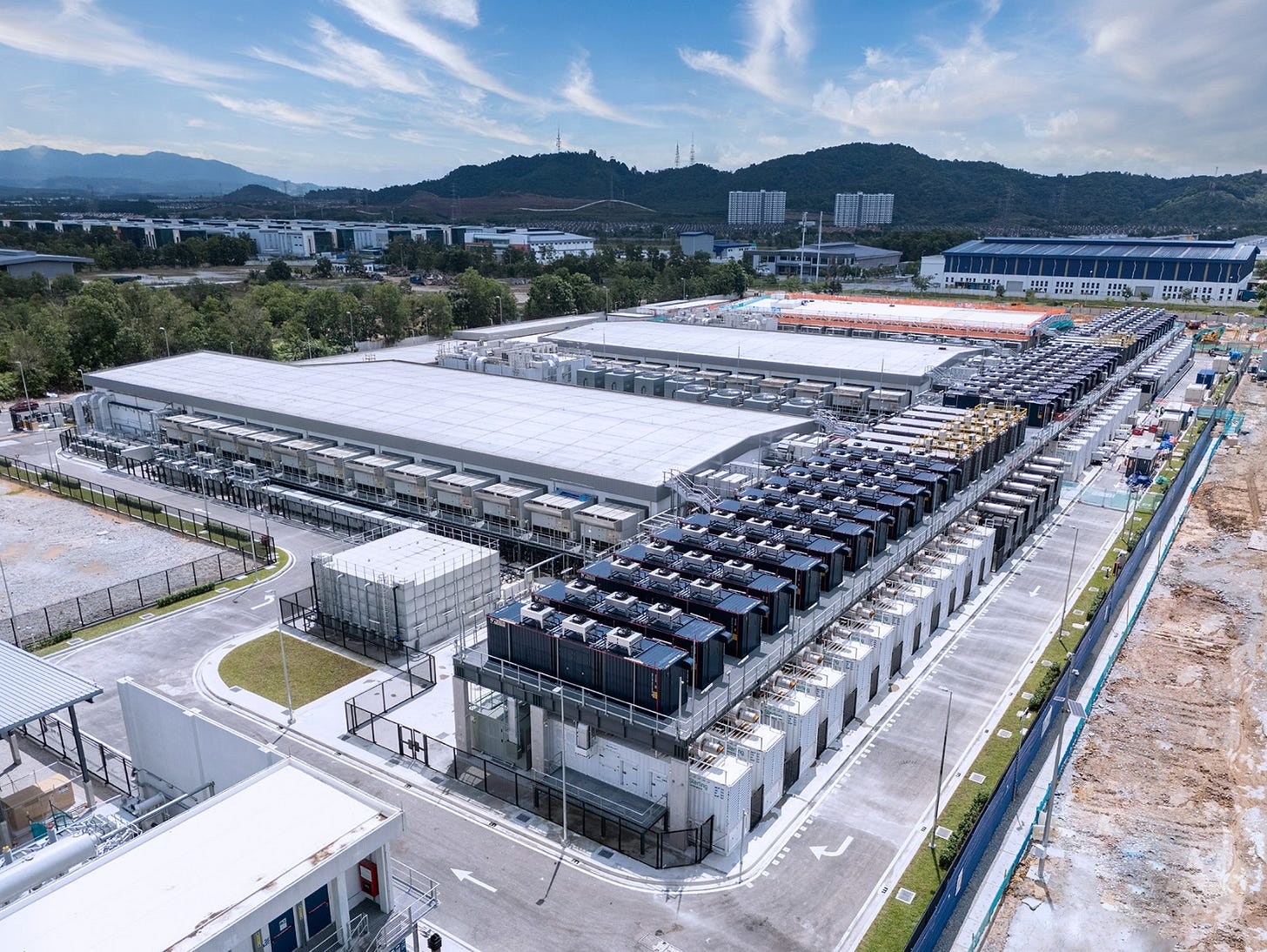Johor, Malaysia: AI Data Centers Drive Investment But Infrastructure Challenges Persists
New Industry, Old Problems: Power and Water Shortages
For the version published on The Diplomat in collaboration with green financing and energy expert Steven Lu, see here.
It’s no secret that Johor, the southern state in Peninsula Malaysia, has welcomed an influx of foreign investors, hoping it will boost the local economy and job opportunities with the boom in data centers being built in the area.
What I hope it’ll also mean is that the local public and private sectors can collaboratively take on a balanced approach to help build up the power and water infrastructure needed, thus relieving some of the pressure on local residents.
A Strategic Location for Data Centers
Due to the ongoing US-China geopolitical tensions, many Chinese big tech companies have looked to expand their semiconductor and digital infrastructure in Southeast Asia, given its proximity and relatively affordable land and resources.
Johor Bahru, the southernmost district of Malaysia, borders Singapore with two links connecting to the city-state. Its proximity and ease of access from the land-scarce Lion City have made it the perfect location to build data centers, mostly to support multinational companies with Asia headquarters in Singapore. [Super technical but well-written piece on Data Centers by
here]In 2019, the inspiration to build more data centers was also further propelled by Singapore’s ban on data centers. Citing Baxter, Johor now has 13 data center facilities across more than 1.65 million square feet of land mass, boosting the state’s position as the largest data center market in Malaysia and the ninth-largest in Asia Pacific.
Johor is expected to bring in US$3.6 billion in new data center investments this year alone, according to CNA’s report, and all these efforts are lauded by the Malaysian government with support in building out industrial parks - Sedenak Tech Park and Nusajaya Tech Park, both over 500 acres in size.
In the meantime, Singapore is also encouraging MNCs to set up corporate HQ in the city while leveraging the country’s special economic agreements with its neighbor up north – the Johor-Singapore Special Economic Zone – that will allow passport-free travel. In addition, talks of a high-speed rail are also happening in the background, which will all lead to an easier free flow of capital and talent.
Open to All – Including China
With the ongoing trade war between China and the U.S., many American allies in the region, such as Vietnam and the Philippines, have taken a subtle stance in leaning toward its American buddy (Daddy). However, Malaysia’s former deputy minister of international trade and industry, Dr. Ong Kian Ming, has said that Johor is here to appeal to both sides of the trade war - whether you’re a US big tech or a Chinese big tech looking to set up infrastructure in Asia.
Johor now hosts data center operations from U.S. firm Nvidia, Australia’s AirTrunk, China’s GDS International, Singapore’s Princeton Digital Group, and Malaysia’s own YTL Power International Bhd. More are coming: Microsoft has purchased land in Johor for a new data center. China’s ByteDance plans to invest approximately $2.13 billion to establish an AI hub in Malaysia, including $320 million for expanding its data center facilities. According to CNA, there are about 50 applications for data centers at present from hyperscalers.
These investments significantly contribute to Malaysia's goal of having its digital economy account for 22.6% of GDP by 2025.
Chinadata Group’s subsidiary – Singapore-based Bridge Data Centers, has existing hyperscale projects currently running and has been ramping up data centers in Johor, according to its investor relations material. Its anchor client has been widely known as ByteDance. Meanwhile, its peer GDS Holdings, another Chinese IT management company primarily serving ByteDance, is also a key driver of growth in Johor. Rumor has it that ByteDance has emerged as the largest client for Johor's data centers.
In fact, during GDS Holding’s most recent quarterly earnings call, the CEO emphasized that Singapore-Johor-Batam is fast emerging as one of the very largest data center markets in the world, and the demand is driven by regional expansion and spillover from the U.S., which is mostly AI related. Breaking down its main customers in Southeast Asia specifically, the current client mix is about 70% Chinese, from three main players- they didn’t disclose, but my wild guess is ByteDance, Alibaba and Tencent.
[It is said that during the same call, the company management said they still hold significant land and power quota, another key factor that we will explore more in another article about how companies that previously held these quotas for crypto-mining are switching lanes to AI computing.]
The Data Center Ecosystem
Observing the burgeoning ecosystem around such rapid development, it is clear that there are spillover benefits for power generation, engineering firms, IT, power and cooling equipment suppliers, construction companies, facility operators, and more. The overall thrust toward energy and water use efficiency to run data center operations more sustainably is driving research into new techniques, equipment, and operation methods. Since most of these are skilled jobs, it also bodes well for upgrading general skills-based employment in the Johor area.
However, no investment can occur without the support of financing. Much like the positive development in financing large-scale solar projects in Malaysia since 2016, data centers now offer a new asset class for banks, private equity specialty funds, and insurers. Financial institutions have been keen to offer green financing facilities to data center developers. Multilateral development banks such as the World Bank Group’s International Finance Corporation have lent their support recently. Commercial lenders, including regional local banks, have been active as well. These include Maybank, UOB (Malaysia), OCBC (Malaysia), Standard Charter, Bank of China, and others.
The Malaysian government is also taking action to harness the boom in data centers. In 2021, it launched the Malaysia Digital Economy Blueprint (MyDIGITAL), aimed at transforming the country into a digitally driven, high-income nation. A key objective is to enhance digital infrastructure, enabling local data centers to specialize in high-end cloud services. The government targets 3.6 billion Malaysian ringgit (around $838 million) in data center revenue by 2025, nearly doubling 2022 figures. To attract investment, the Malaysian Investment Development Authority (MIDA) offers tax incentives, including income tax exemptions and reduced import duties for qualifying operators.
In 2022, the government introduced the Digital Ecosystem Acceleration (DESAC) incentive scheme to bolster the digital ecosystem by attracting technology investments. This initiative focuses on digital infrastructure providers and offers a 100 percent investment tax allowance on qualifying capital expenditures.
Challenges Linger: Power and Water Shortage is Not New
While all the politics and policies seem to be encouraging for Johor’s data centers, a significant factor that is overlooked is the potential lack of ability that Johor is able to provide stable energy and water to power the sudden surge of data centers, which requires vast amounts of resources.
Just earlier this year, in April, parts of Johor reportedly experienced a water shortage that severely affected the local resident’s daily lives. Parts of the area have also been said to have experienced power outages in December last year, and these incidents are not being fully addressed head-on with the increasing demand for power and water from the data centers (for cooling the data centers). [See here - why companies are not going full renewable to power data centers yet].
Kenanga Investment Bank Research wrote that their estimate for potential electricity demand from data centers in Malaysia will hit a maximum demand of 5 GW by 2035, while the current installed capacity for the whole nation is only about 27 GW, according to Tenaga Nasional Berhad.
NTU’s Dr Wen recently told CNA that these issues are “not necessarily insurmountable obstacles.” My question is when and how authorities will fix this problem. If people nearby cannot access safe water for drinking and showering or electricity for their daily lives, then wouldn’t this cause social disruption and likely also affect the reliability of the super data centers? What’s the right thing to do? Bring in the money first, then fix the issue? Or fix the issue first (but with what money), then bring in the monster demand?
For context, Johor has always had a history of experiencing both water and power shortages that predate the recent surge in data center developments, and the issues have been influenced by the environment conditions as well as infrastructure challenges. The region has always faced periodic droughts. In 2016, water rationing was even imposed on residents. Infrastructure upgrades have been needed for decades, too. Major blackouts have happened throughout the last two to three decades, and the recent surge of data centers being built locally has intensified criticism from citizens and authorities that the region’s current infrastructure just isn’t cut for it.
But to be fair to the local government, some efforts are being made; authorities seem to understand that power right now is a major bottleneck, and to address this issue, the country launched the Green Lane Pathway initiative in 2023 to streamline power approvals and to reduce the lead time to as short as 12 months for data centers.
Johor Bahru City Council Majoy Datuk Mohd Noorazam Osman raised concerns about the livelihood of the local population and that securing reliable water and power infrastructure is key, and he hopes to see more private and public sector collaboration on this front rather than just focusing on data centers.
So that brings us back to the international capital injection angle; investments currently have been focused on building out data centers, but could it expand its mandate and help improve the infrastructure, or can the MNCs collaborate with the government to improve water and electricity supply systems first since those would be key ingredients to run effective data centers – which is the main objective for the companies. It could maybe all be a virtuous cycle; by investing in infrastructure can improve the standard of living for local residents and business operations, but then again, maybe I’m naive.






Someone really needs to study how these places mess up the infrastructure for the real economy, where physical goods like food, etc, get expensive because they have to compete for power and raw materials, while producing very few long term local jobs and most of the income shows up in a tax shelter.